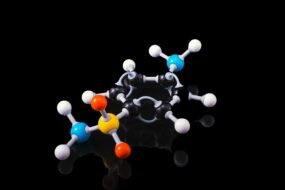
Piroxicam is a long-acting and potent NSAID with anti-inflammatory and good analgesic-antipyretic action. It is rapidly and completely absorbed in the GIT and is significantly plasma protein bound.
It is metabolized in the liver through hydroxylation and glucuronide conjugation and then excreted in urine and bile. Plasma t½ is long, nearly two days.
Mechanism of action.
It is a nonselective, reversible inhibitor of the COX enzyme.
- It lowers prostaglandin concentration in synovial fluid.
- Inhibits platelet aggregation hence prolonging bleeding time.
- It decreases the IgM rheumatoid factor and leukocyte chemotaxis, inhibiting inflammation.
Clinical uses.
Used in the management of:
- Rheumatoid arthritis.
- Osteo-arthritis.
- Ankylosing spondylitis.
- Acute gout.
- Musculoskeletal injuries and in dentistry.
Adverse effects.
- GIT disturbance.
- Rashes and pruritus.
- Edema and reversible azotemia.
- Headache, dizziness, and tinnitus.
Drug interaction.
- Acebutolol and piroxicam increase serum potassium; hence should not be administered together.
- Nirmatrelvir increases the level and effect of piroxicam by affecting hepatic/intestinal enzyme CYP3A4 metabolism.
- Ketoprofen increases the level and effect of piroxicam by acidic drug competition for renal tubular clearance.
Contraindication.
- It should not be used in case of allergy to the drug.
- Bleeding disorders.
- Duodenal/gastric/peptic ulcer.
- Ulcerative colitis.
- Upper GI disease.
- Late pregnancy.
Dosage.
- 20 mg BD for two days, then by 20 mg OD:
- DOLONEX, PIROX 10, 20 mg capsule, 20 mg dispersible tablet, 20 mg/ml injection in 1 and 2 ml amps.
- PIRICAM 10, 20 mg capsule.












